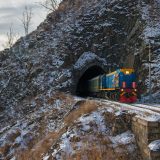It’s Siberia 1993, 18 months after the collapse of the Soviet Union. Lighting three burners on the stove blows out the apartment's electricity, while the tap water smells like ham one day and petroleum the next. Still, Sharon Hudgins, author of “T-Bone Whacks and Caviar Snacks,” falls in love—with cabbage pies and caviar, the vast landscape, the Trans-Siberian Railway and even the house spirit who lives under that stove.
When they moved there in 1993, Hudgins and her husband were some of the first Americans to live in Siberia—an area that had been largely off-limits to Americans for decades. On Milk Street Radio, Hudgins recounts her experience discovering Vladivostok, how the city has changed since she first moved there and everything in between, including what it was really like to ride the Trans-Siberian Railway. Listen to the full interview here, and check out the excerpts below.
On her first apartment in Vladivostok
You never used the elevator because the electricity was so erratic, you didn’t want to get stuck for a couple of days between floors. That erratic electricity was a problem in the kitchens, too. The kitchens were small—this was a 700 hundred square-foot apartment—we had the luxury of a refrigerator (a lot of other people just kept things refrigerated on the little balcony attached to their apartment) and we had a three-burner stove that soon became to be called the stove from hell because if you turned on all three burners at once, it burned out all the electricity in half the apartment.
On the house spirit that lives under the stove
He’s called the Domovoi and he can do bad things or good things depending on how you treat him and depending on the mood he’s in. And this is something that Russians throughout the country have believed in for many hundreds and hundreds of years. So he’s kind of an explanation for things that go wrong.
On Siberia’s landscape
There’s this misconception that Siberia is this big, vast, frozen wasteland. But instead, it’s several thousand miles across, it’s at least a thousand miles—in some places even more—from north to south, and so it’s got everything from 10,000-foot snow capped mountains to grassy steppes to beautiful forests.
On the Trans-Siberian Railway
Up until World War I, they actually supposedly had very good food service. But beginning with the Soviet era, the food supply was so limited that they would have a 10-page menu, but there were only two items that they actually had. So you brought your own food with you, and/or you bought it from the platform vendors on the way. And that’s a neat way to eat. If you’re starting in Vladivostok by train, you’d buy things like salmon caviar in a jar or fresh seafood. More toward the interior, there’s a lot of the Russian home cooking that’s boiled potatoes with sautéed mushrooms and fresh herbs on top. Or little pies, milk and kefir and yogurt.
On the importance of family in post-Soviet Russia
When you went home, the family life that you constructed was the good side of life. The difficulties were when you went out and were dealing with the bureaucrat at work or lack of income because there was no pay right then. But people that I knew, I don’t think they felt emotionally deprived. They felt materially deprived. And they were able to balance that in a way that I admired.
This interview has been edited for clarity.



